3 traits Digital Software Partner must have
- August 31
- 4 min

Paweł: Many know that picking up the right software vendor for a project is a complex task. This type of buying journey is definitely a long one. There are many aspects to consider before making a final decision, and we couldn’t imagine having a better person to share the most and least essential elements. That is why we would like to invite you to check out this article based on an interview with our expert – John Treadway, the owner and the CEO of SquadGurus.
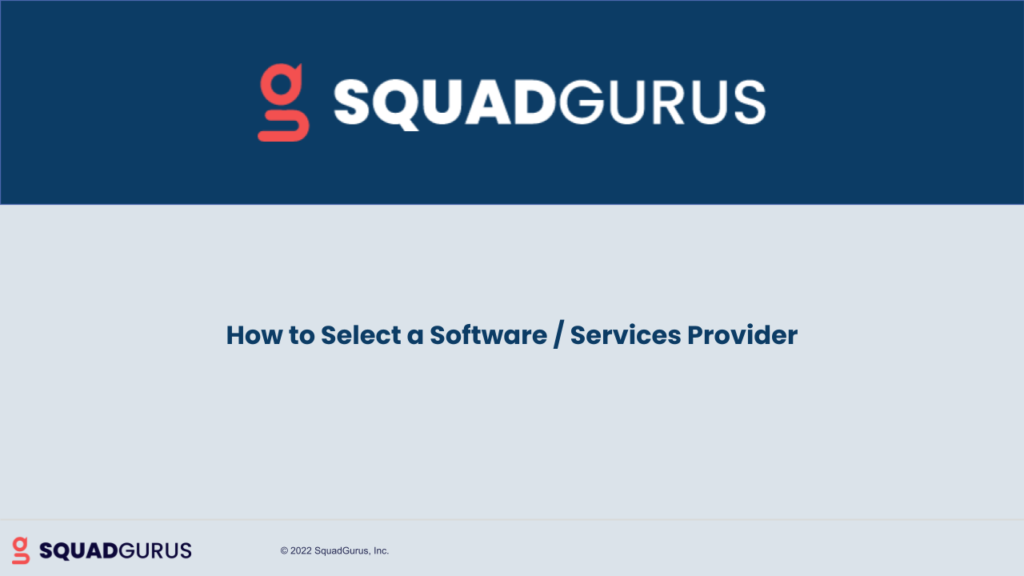
John: The SquadGurus has been in business for about two years and our focus is on helping our clients through the process of actually selecting a software house, selecting a software vendor to help them with projects, building teams to do product development, and even staff augmentation. We’ve been doing it for the last two years, and it’s based on our background and experience as a team, having both sold and also delivered a wide range of IT services over the years. So it is a quite long time.
We actually understand what’s important, and we’ve seen all of the successes and failures that happened as a result of that. That is why we would like to take you through this process here and, at a very high level, tell you how we approached this.
Our model for selecting the right software services provider is very straightforward – we start with a little bit of advice and some strategy, to help you figure out what the right answer should be in terms of where you should put your team, or what are the essential factors you need to have. Then we’ll help you go through the sourcing process, we post your needs and we get our partners to come back with their responses, proposals, and candidates – if that’s what you’re looking for.
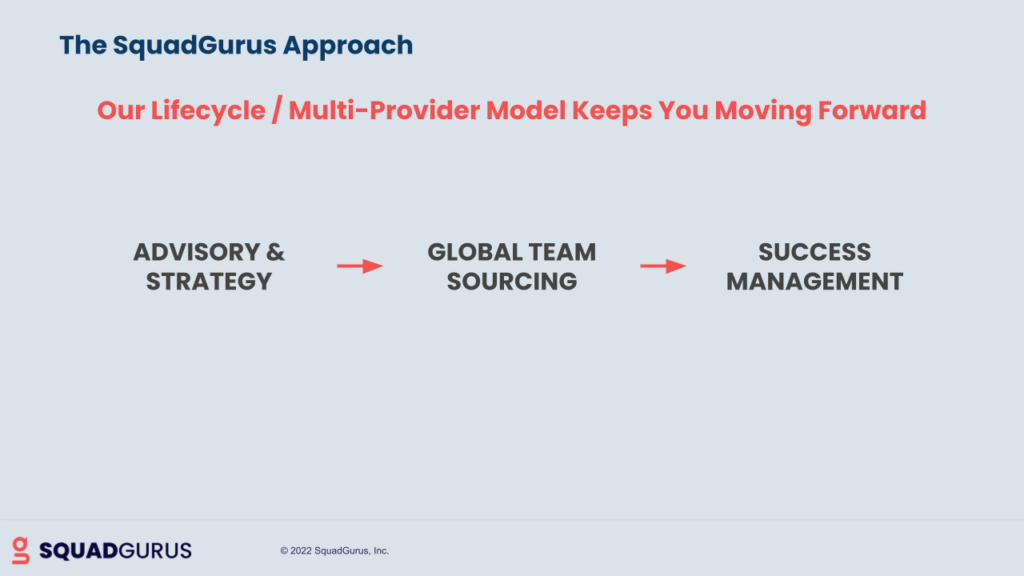
Once we’re through that process and selected them and you’ve gotten everything onboarded or projects started. We help manage the end-to-end customer success and make sure that you’re successful with this relationship all the way through like escalations, billing and time tracking, or whatever you need – we’re there to help you do that.
First of all, the sourcing has to be in the right location, the right time zones, we have to have a good evaluation and selection criteria model. How do we go about that? I’ll take you through the contracting process as a client. We don’t spend a lot of time on that here, but we help you manage through the contracting process, including statements of the work and all the financial operations. And as I said, onboarding and customer success are a big part of that.
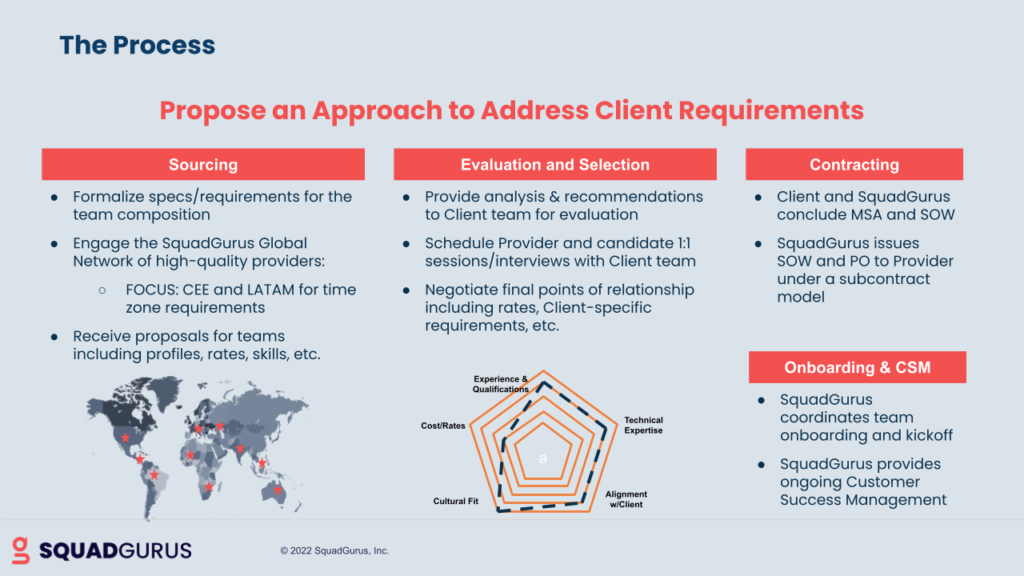
The really big thing that we start with here is trying to understand what you’re wanna accomplish first and then building a model that makes sense for you. And we’re gonna get into some of the nuances here about what’s important and what’s not important in this process. So let’s ask ourselves some important questions first:
For example, Hicon is in Poland; Poland is the leading tech hub for all of Europe. We have a lot of clients from Europe and the U.S. doing work in Poland. High quality, high success. But there are other markets as well. Romania and even Ukraine are still in business with everything going on there. And that’s just in Europe, many countries that you can do outsourcing from. And we are also looking at places like Africa and Latin America and the Asia-Pacific region and so on. So once we have a really good understanding of what the capabilities are, and the characteristics of each environment or each region and regional hub, we start looking at the providers that are in those markets themselves.
Before I move to the specifics of the providers, we’re looking at things from a regional perspective. Add some more important questions then:
Foremost, we’re looking at the experience and qualifications of the provider themselves. Like what?
Ask yourself and think very carefully before you start with something.
Some software vendors are very large, very broad, and can handle a range of technologies. And some are smaller and very narrowly focused on only a few technologies that they get really good at.
We all know that, particularly for small and mid-sized firms, there are things that you’re really strong at, things that you’re okay at, and things that you probably should let other people do. We look at factors like the cost of the firm, the margin structure, and the cost structure of the labor. And then, of course, overall alignment across kind of various characterizations of the working model and how do you manage projects and what’s your methodologies and your philosophy towards people and so on.
And at the end of the day, we start with the regional choice. Make sure that we’re in the right place or places. Then we go into the provider view and, then we help you sort through that process and help you make the final decision about which software services provider or providers you should go with for a given need and then help you structure the relationship to be successful.
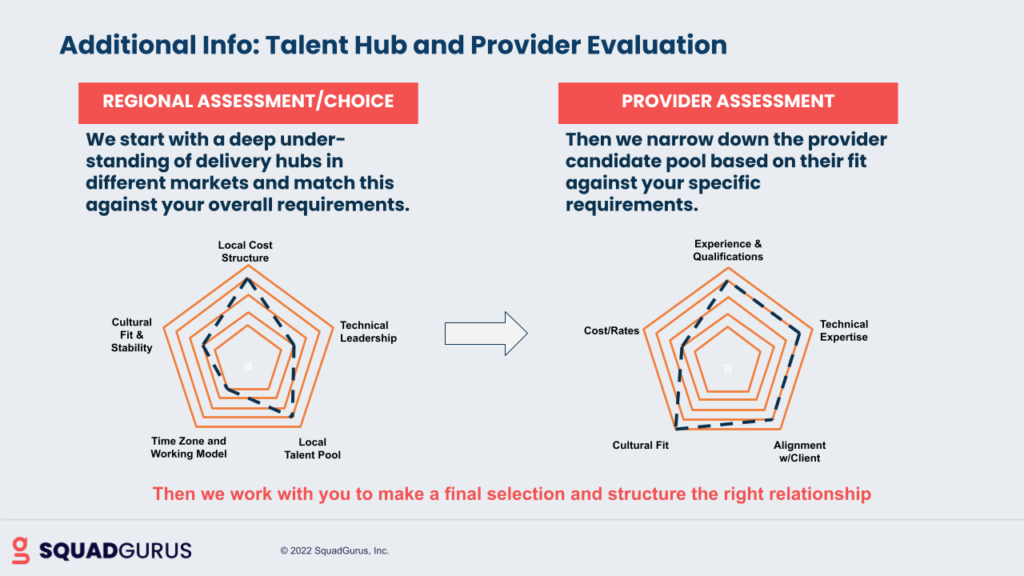
This is some part of the background that we look at in each of the provider talent hubs to really get a good understanding of what should go so that we could give the right advice. So we do a lot of research and we kind of keep up to date on what’s going on.
What else helps with selecting the right software services provider? One of the things that’s really important is time zone, and we get this question a lot like:
You can be a European client, you may be in France or Germany, or maybe you’re even in the Nordics or somewhere else. So:
Some people do move further east out to Asia and some people stay kind of in Central and Eastern Europe, further outsourcing, or, they even look at domestic partners looking at, I’ll say onshore. So there’s onshore in the nearshore. If you’re in the United States or Canada, you might be looking at Europe again, but you also might be looking at Latin America because of the time zone factor.
A lot of our larger clients will have teams and projects going on in multiple geographies, in multiple locations because they have the maturity, the structure, and the tooling necessary for that to be successful. And it requires a little bit of extra coordination. You have to think about how you’re going to pass the work around if you’re going to do that, and whether or not the teams that are managing them or are engaged with them that are part of your internal team, are able to work around the timezone issues that might come up. It’s pretty important.
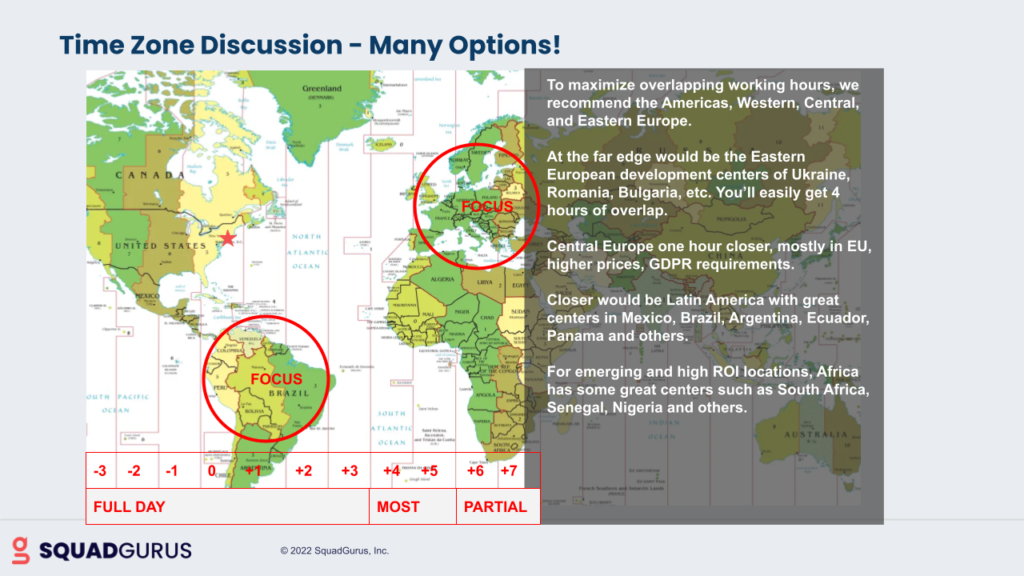
There are things like:
That’s the time zone discussion at a pretty high level. It really comes down to a lot of preference. But we can help guide you on that decision process.
There are more ways to evaluate vendors than we’re going to cover here. But what’s important to understand is that it’s not just one way. It may be that this kind of model like a provider comparative matrix may be the best way for you to go forward because it shows you very clearly who’s really aligned and who’s not.
Different providers and software houses may have different alignments against the things that are important to you. You can do that really in a red, yellow, green kind of model, or you can even go to the next level, which is really more formal. This is really important to me and I’m going to weigh it very high, like methodology and approach. I’m going to weigth that at 30% and I’m gonna say, everything’s on a 0 to 10 scale and so, when I go through the whole process.
In public sector procurement and in large-scale RFP operations, that’s more common. In a traditional commercial decision using these scoring models sounds really great, but they can be a little bit restrictive because it’s really hard to be that precise about what the weighting should be on something. And you may find that there are factors that are more important than you think as you go through the process – that’s where we backup.
We look at the regional, we look at providers, and we look at different scoring or different evaluation models. And at the end, how it works with our clients is that people come in, they put their opportunities into our system, we go out and work with the service providers to get proposals and to get engagement.
When we have the right answers or enough of the right answers out there, we’ll lock down the process and go through the vendor evaluation process with you and then help you, eventually, make that decision. So, that’s the process. That’s what we take.
There are a lot of factors we’re going to get into some questions about what works and what doesn’t. But I did want to give you a sense of what the methodology is.
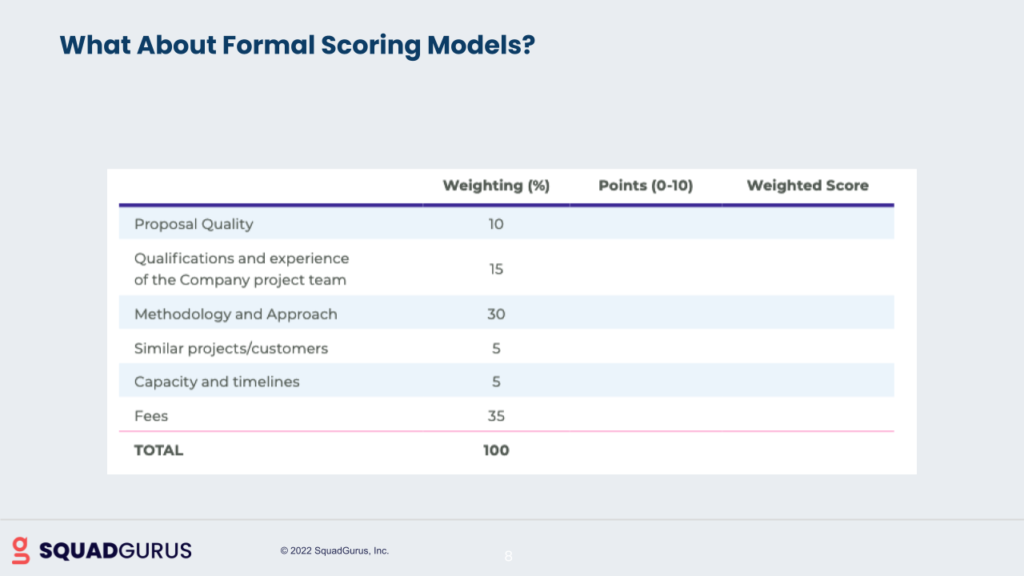
It comes down to the following factor and I’ll say it’s a mistake, but I’m going to say that it’s a forced error. The forced error, not one that was unforced. Let’s talk about it as it is in tennis. In this sport forced error means – I made you make a mistake and unforced error – I made a mistake without any help.
The forced error that happens most frequently is that if you look at the landscape of software vendors, and software houses out there, the numbers are mind-boggling. It’s tens of thousands of firms globally that can help you. And every day I literally find out about a new company, including ones started by friends of mine. That has started up because at the end of the day, hanging out your hat as a software vendor doesn’t take a lot of effort.
If you’ve got the right technical skills and you’ve got some good business sense, you can actually get started. You may not be very big yet, you don’t have a lot of client references, but it’s not hard to get started. And over time, if you stick with it, your firm gets bigger and you get more references and then you kind of get interesting.
Over the last 30 years, there’s been an explosion, just tens of thousands of companies out there. The unforced error is that looking at that broader market makes it really daunting. I don’t want to go through the process. I don’t even know where to start. So, what do I do? Do something that works. It doesn’t always work, but it does work many times.
It’s not necessarily the most methodical approach, which is that ask around. I know as a vendor, and the same thing with us, like we love referrals from friends. Referrals from friends are really important. They get us a lot of our business and particularly when we get a referral from a friend, from somebody who knows us, a former client, or an existing client or a partner, we take extra attention and care because the relationship that came from is really important to us. That said, all the best intentions decide, a referral from a friend may not get you to the right vendor.
So I’ll ask somebody, “Hey, tell me about who do you use for X? Who do you use for Cloud? Who do you use for Angular development? Who do you use for doing IoT (Internet of Things) work?”. And you’ll get an answer from somebody and they might have had success, but your requirements are going to be different. Your needs are going to be different. The way you work internally is different and, of course, your people on the team will be different – in most cases. And actually, that’s the critical factor here.
There’s only so much you can control with methodology. The most important thing is who you’re going to be working with.
That’s really hard to judge. When somebody says, “Oh, yeah, you should use Hicron and Hicron’s a high-quality vendor and it works great.” It is ok, for them it is but every client is different, and not every client is ideal for any single provider. It’s because it’s so daunting, you take a shortcut and that shortcut can work out well, but it does introduce a fair bit of risk.
If you haven’t done a real thorough search and taken the approach of “I really need to get enough responses so that I’m really comfortable. Are these really the right guys for me?” Actually, in a lot of cases that process will confirm, “Hicron – I got referred, but they really are the best for me.” That’s great. But if the answer is that another vendor is going to give you a lot better chance of being successful, that’s who you should go with.
You shouldn’t go with somebody just because they were referred to you. That’s the number one mistake that we see. It’s an unforced error because the market’s so big, it’s just so daunting. And without somebody like SquadGurus, you don’t really have a guide to help you through that process. Where we’ve done the research, we don’t know every provider that’s out there, but we have pretty wide-ranging knowledge of providers and we can bring new providers into our network very quickly, evaluate them and stand them up. If there’s some specific need, we can find a proper one.
Check what 3 traits your digital software partner should have!
Paweł: There are many things to consider, but the network works only in some sort of way. From the provider’s point of view, it’s always good to start the company from the strength of the network, but it only works on some level. After five or ten projects you also need to be methodological in your approach. Sometimes these approaches are connected with each other, so, someone says that the company name X could be good for you and this is the truth, however, you need to compare, you need to get the feedback that will be backed up with the data – about the people, about the company, and about the portfolio.
John: There’s another factor, I’d say that maybe is equally used. That isn’t always the right answer for everybody, which is let’s say I’ve already been working with some vendor and in a lot of the larger enterprises, it could be Capgemini, Accenture, Deloitte, some other larger vendor, or some other vendor that I’ve been working with for a while. They’ve done good work for me, but over time, relationships don’t always grow the way that you want them to. And as a client, one of the things…
There is an analyst that I spoke with a couple of years back and he works with a lot of large enterprises of well-known analysts firm. This person runs research for the outsourcing of SaaS application development. That’s the company’s focus.
The clients will give this person the name of their service provider or their best service provider and say, “these guys are really great.” But the reverse will be asked. The last service provider – what clients can I talk to that would be references? And they’ll get the names of some clients and they’ll call up this client, some bank or some manufacturing firm, a media firm.
And this is the one:
“You gave me, Mr. Vendor, you gave me this client as an example of one of your successful clients. And when I called them up, they don’t like you at all. They really don’t like you at all. They haven’t been happy with you for a long time, but you don’t know that.”
Why don’t you know that? You don’t know that because they complained back in the day or they’ve complained recently, but they don’t get any relief from what they’re doing. And there’s a great thing to be in the software house business, particularly with long-term teams. The intellectual property knowledge is in the head of the people that you’re outsourcing to. It’s very sticky, but that makes it risky, meaning that if you don’t have the right processes in place and the right controls in place. It kinda locks you in and gets you to a point where you are making the decision to stay with somebody only because the breakup cost is too high, but not because you’re happy – just like in a marriage or any relationship.
There’s a cost to ending any kind of relationship and sometimes that cost is just too high or too high for a long period of time. So what happens is that the fact that the relationship has to get incredibly bad, very toxic before you move off. We worked with a client who had a good relationship with his vendor, but also understood this risk.
It was a European medical device company and they asked us to help them find another company that can do it better software development for their medical devices. We did a full survey and full review and really what they wanted is to have a second source. They wanted to have a little bit of risk abatement against the vendor that they had. It turns out it was a good idea.
The vendor also had quite a bit of a team in Russia, which now they no longer want to be working in. That situation where every time I get a new project, I just go back to the same vendor, and that same vendor is okay. They can do the work but aren’t the best to do it and we saw this a lot in my previous company.
I worked at a cloud consultancy and we were a startup. We were very early, very young, but large enterprises would bring us in and they’d say, “We’d like to work with you because you’re not Accenture, because you’re not IBM is you’re not Deloitte, because everybody in your company does this one thing and knows it deeper and better than anybody else.” Particularly for emerging technologies like AI and machine learning and even cloud, to a degree, ok, it’s mature, but there’s still so much to be learned or quantum computing or blockchain, web3 kind of technologies. You need to work with companies that are really steeped in this domain, and your existing vendors may be able to say the words, but can they really do the work?
Paweł: Thinking about the tech fit and niche, it’s extremely essential for both sides – the vendor and potential client to succeed – it may be a really interesting topic.
The typical B2B buying journey for such a complex solution as software development definitely takes time, but there are some conclusions that you can draw after just visiting the provider’s website or getting through the profiles of software vendors listing, just like SquadGurus.
Let’s talk about one of the red flags – when a company or provider is pretending that they are not from the country that they really are. For example, you have a Polish software development company and they are pretending that they are from the United States, but they have just like two people from there and like 100 people from Poland. This is one of my favorites because how can you trust some company if they are fake just from the first contact.
John: When we have a software vendor provider, we called a service provider. When a service provider approaches us, we do a little bit of background check. We’ll look at their website will also look for any additional things.
That tells us at least they have clients that are willing to do the work to put those reviews in. But we’ll also look at their LinkedIn profile:
Assuming we tend to want to have companies that are 50 people or more, so these that been around for a while.
We’re looking at that as well. And we’ve seen the same thing. Somebody is “I’m out of San Antonio or Austin, Texas.” Okay, except for the fact that that’s where your corporate, you have LLC in the United States is that can do contracts, but none of your team, including in some cases, not even your sales team is here, they’re somewhere else. So that’s a factor that we definitely see as well.
There is another factor that’s interesting. In particular, why companies are working with the same vendors over and over again. And that’s the cost of procurement and onboarding of a vendor and how difficult that can be when you’ve got a procurement process, a financial process, and a legal process. Getting through master services agreements. I’ve had cases where it’s taken 18 months to negotiate an MSA with a large telco.
I’ve also had situations where I can get an MSA done in a day with a smaller company. It really depends on the relationships that you have. It depends on the speed of your procurement operation and so on. It may take a little bit more time and a little bit more effort than working with Accenture or your usual vendor. But it’s often very much worth it because the smaller or mid-sized vendors that are really nimble and focused on your areas will deliver more for a lot less money and a lot less time than the big vendors that don’t really know what they’re doing in the States.
There are a number of factors, and that’s an area where a lot of clients that I work with. They don’t have a really good handle on how to manage the vendors appropriately, and a lot of it depends on what they’re doing. If it’s a managed team, eventually over time they’ve got the team integrated into their development infrastructure, working with their project management tools and their collaboration tools, and they start to get into a rhythm and it feels good.
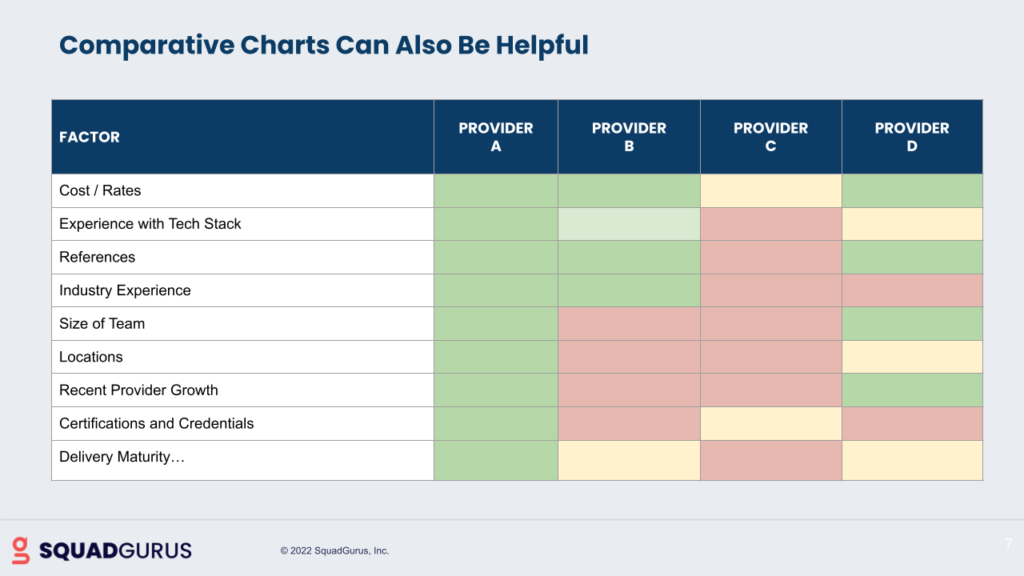
It feels like they’re getting the velocity that they’re looking for and they may not be measuring velocity the way that some people do. Velocity is a very hard thing to measure in a software development process. One of the bigger factors is internal customer success. We try to look at not only “is the client happy with the work being provided? But is the team happy providing the work?” – meaning the internal customer satisfaction and the satisfaction of the team.
It’s usually one of the earliest factors that will let you know whether somebody is successful is If the developers are dissatisfied and they’re turning over, meaning they’re asking their manager to take me off this project or put me on a different project. If that’s happening more than once or twice in six months, then you may have a factor where there’s something going on. It could be an issue with the way the client’s working. It could be an issue with the way that the team is being managed internally. But something’s happened where the people are not happy anymore. When we look at one of the key factors for success:
The ultimate tip is to plan for the time that it’s going to take to do it right. We can accelerate that a lot, but there’s still going to be work that needs to be done on your end. Don’t just accept: “Procurement says this is going to be the right vendor because they’ve got the best cost structure”, or “A friend referred them” or if you are doing work with the cloud in your AWS rep, your Amazon Web Services rep says, “Hey this is one of three names of vendors that I work with a lot.”
That’s a great place to start. But know that the work that you’re going to do to select the vendor the right way and to get out to all the right factors is going to pay a lot of dividends down the road.
There’s an old saying in the carpentry business: measure twice, cut once. That saves you time and it saves you a lot of wasted material. Once you have gone down the road with the vendor and with the software house and you’ve made that commitment. It takes six months to a year to know whether or not you’ve made the right decision. Do the work upfront to really know it.
Oftentimes what I advise is for the client and the vendor to work on a pilot project together. Before you make that full commitment, maybe get started, try something, and see if it works. See if you like the way that you’re working with the team.
You can test this and it’s kind of like anything else, like try it before you buy it. Do you buy a car without driving it? Usually not. You usually want to know if that car is going to be the right car for you. It’s way more important that you test drive your vendors one way or the other. You can do this in a lot of ways, but it could be a PoC project, it could be just taking them through the whole proposal process. Let them do some design work for you, whatever that gate is that that will help you and do the evaluation, do the diligence and make sure, most importantly, that the people that you see in front of you when they’re selling to you are the ones that are committed to be a part of your delivery team.
As we mentioned before, “The company says they’re in Poland, however, they’re actually or they’re selling U.S, but their whole team is in Ukraine or they’re in Poland or in Africa.” The next one is I put a really super sharp architect in front of the client. It’s okay if that architect is not part of the delivery project, but you need to know who’s part of the project. Do you need to meet that person who is the leader of that project? Who are the people on the team?
You may not do full interview and evaluations, but you should know what their capabilities are, what they’re capable of, what their skills are, and what their certifications are. Don’t take it for granted. “Oh, well, you know, they’re bringing these guys and they’re probably pretty good, right?” But be a little bit of a pain in the butt. Be very difficult upfront with talent and quality.
We always talk about Mythical Man-Month problem or the Tenix Engineer. It really is true that a high talent individual can outperform a mediocre talent individual by multiples, not just by a little bit, but two or three times better. So insist on the best talent and if you start getting unqualified resources on your team, deal with it immediately. Don’t pay for the people that are not delivering.
